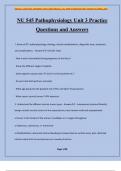EMILLECT 2024/2025 ACADEMIC YEAR ©2024 EMILLECT. ALL RIGHTS RESERVED FIRST PUBLISH OCTOBER, 2024
NU 545 Pathophysiology Unit 3 Practice
Questions and Answers
1.Know all STI: pathophysiology, etiology, clinical manifestations, diagnostic tests, treatment,
and complications. - Answer✔✔-Use EB's chart
· How is each transmitted during pregnancy to the fetus?
· Know the different stages of syphilis.
· what organism causes each STI and is it viral, bacterial etc.?
· Do you treat both partners and why?
· What age group has the greatest risk of STIs and why? Young women
· What causes cervical cancer? HPV exposure
2. Understand the different uterine tumor types - Answer✔✔-· Leiomyomas (uterine fibroids):
benign smooth muscle tumors in the myometrium; most remain small and asymptomatic
o Occurs in the fundus of the uterus in multiples or in singles throughout
o Subserous, submucous, or intramural
o Manifestations: abnormal uterine bleeding (increased uterine surface area), pain, distorted
uterine cavity that can put pressure on a nearby structure
Page 1/38
,EMILLECT 2024/2025 ACADEMIC YEAR ©2024 EMILLECT. ALL RIGHTS RESERVED FIRST PUBLISH OCTOBER, 2024
o Evaluation: enlarged and irregular uterus; confirm diagnosis with MRI
Treatment: GnRH antagonists, IUD, oral contraceptive, hysterectomy or myomectomy (removal
of fibroid)
3. What is PCOS and what does it cause? Clinical manifestations? Treatment? Causes?
Pathophysiology? - Answer✔✔-· At least two of the following: irregular ovulation, elevated
levels of androgen (testosterone), polycystic ovaries on ultrasound
· Patho: hyperandrogenic state is a cardinal feature, glucose intolerance increases the severity
· Manifestations: obesity, menstrual disturbance, hyperandrogenism, DM, HTN
· Causes: associated with metabolic dysfunction, dyslipidemia, insulin resistance, and obesity
· Treatment: goal is to reverse androgen excess and causing cyclic menstruation; first line is oral
contraceptives to establish a regular period, weight loss, progesterone therapy if pregnancy is
not desired
4. What is the difference between primary and secondary amenorrhea and what is
compartment II? - Answer✔✔-· Primary amenorrhea: failure of menarche and the absence of
menstruation by age 13
· Secondary amenorrhea: absence of regular menses for 3 months or irregular menses for 6
months in women who have previously menstruated; exclude pregnancy before further
evaluation
Page 2/38
,EMILLECT 2024/2025 ACADEMIC YEAR ©2024 EMILLECT. ALL RIGHTS RESERVED FIRST PUBLISH OCTOBER, 2024
· Compartment II: disorders that involve the ovary and are linked to genetic abnormalities;
gonadal dysgenesis (turner syndrome) or androgen insensitivity syndrome (AIS)
5. What are the signs of puberty in girls and boys? What delays puberty? - Answer✔✔-·
Reproductive maturation involves the hypothalamic pituitary-gonadal (HPG) axis, the CNS, the
endocrine system; adrenarche is the increased production of adrenal androgens (axillary and
pubic hair growth and body odor)
· Girls: 8-9 years of age, with thelarche (breast development); puberty is complete with the first
menstrual period (could be 1-2 years after menarche or first period)
o estradiol causes breast development, maturation of the reproductive organs, and fat deposits
in the hips
o estrogen and increased growth factors leads to rapid skeletal growth in girls and boys
· Boys: 11 years of age, occurs with increased weight and BMI; complete with the first
ejaculation of mature sperm
o Testosterone causes growth of testes, scrotum, and penis
· Delays in puberty: lack of circulating estrogen leads to inadequate bone density; low
gonadotropin levels: need skull imaging to rule out pituitary or other CNS tumor
o Girls: functional hypogonadotropic hypogonadism (FHH), disruption in the HPG axis; treat with
estrogen
o Boys: deficient FSH/LH, disruption of HPG axis; treat with testosterone
Page 3/38
, EMILLECT 2024/2025 ACADEMIC YEAR ©2024 EMILLECT. ALL RIGHTS RESERVED FIRST PUBLISH OCTOBER, 2024
6. What is the pathophysiology behind the signs and symptoms of menopause? - Answer✔✔-·
Cessation of ovulation and menses due to ovarian failure, marks the end of reproduction;
premature menopause (before 40 years old); defined by the point that marks 12 consecutive
months of amenorrhea
· "climacteric": gradual changes of ovarian function that start before menopause due to a loss of
ovarian follicles resulting in reduced ovarian production of estradiol, increased FSH/LH, and
decreased inhibin
· Changes:
o Ovarian: utero- number of follicles steadily decrease, starts in the late 30s
o Uterine: primarily endometrium affected, proliferative growth; longer exposure to estrogen
causes greater thickness of endometrium which causes heavy/unpredictable bleeding
o Breast: become smaller and lose firmness because fat deposits increase
o Genital tract: vagina shortens and loses elasticity, vaginal pH increases which causes vaginitis,
urethral tone declines causing frequency/urgency/UTIs/incontinence (estrogen deficiency)
o Systematic: vasomotor flushes (hot flashes) due to rise in temp and dilation of blood vessels
and increased noradrenaline levels
o Cardiac: as estrogen levels decrease, BP and LDL levels rise which causes weight gain
7. What does breast milk contain? - Answer✔✔-· Breast milk is the most appropriate
nourishment for newborns.
Page 4/38




